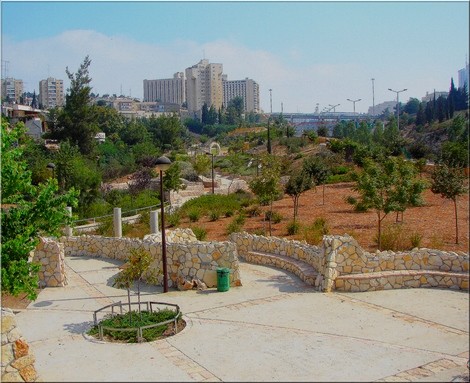Yissum, the Technology Transfer Company of the Hebrew University of Jerusalem, is launching a 1 million U.S. dollar program to support the development of outstanding cleantech inventions by scientists at the Hebrew University of Jerusalem. The launch will take place on December 25th at the Givat Ram campus of Hebrew University and feature a keynote address from Yehuda Bronicki, Chairman and CTO of Ormat.
Yissum’s business partners include companies such as Novartis, Microsoft, Johnson & Johnson, Merck, Intel, Teva and many more. “We are pleased to launch Yissum’s Cleantech Programme, in response to the growing need for alternative energy solutions, novel technologies to combat water shortage and cleaner technologies to protect the environment,” said Nava Swersky Sofer, President and CEO of Yissum.
“We hope that this initiative will assist in bridging the gap between the Hebrew University’s cutting-edge research in these fields and the product-based industry, leading eventually to the commercialization of new “green” technologies for the benefit of us all.”
Initially, five novel technologies were chosen, three of which aim to reduce the polluting effects of toxic substances and create alternative, clean, energy sources. These inventions involve the generation of clean fuel, detoxification of gasses emitted by burning fossil fuels and detecting toxic chemicals.
Burning fossil fuels for the generation of energy is the major cause of air pollution and global warming. The consumption rate of oil, gas and coal is estimated as the equivalent of 200 million barrels of oil per day, and approximately one million people die annually due to air pollution resulting from fossil fuel burning. Furthermore, fossil fuels are a diminishing energy source and their limited supply has a far-reaching political and social impact.
Reducing Mercury Air Pollution
Prof. Yoel Sasson, from the Hebrew University’s Institute of Chemistry, and his team invented a novel method for the effective clearing of poisonous mercury from gases emitted into the atmosphere by coal-fired power plants. Elemental mercury and particularly organic mercury are devastating poisons, particularly to the central nervous system. Exposure to mercury can cause immune, sensory, neurological, motor, and behavioral dysfunctions. A major source of mercury in the environment is coal fired power stations. The mercury contained in the coal evaporates in the process of burning and released with the flue gas to the atmosphere. It later returns to earth surface with the rain and snow. It is estimated that 50 tons of mercury are annually spread over the U.S. due to burning of coal for power generation.
In 2005, the U.S. Government’s Environmental Protection Agency (EPA) issued a final regulation for control of mercury emissions from coal-fired power plants (Clean Air Mercury Rule- CAMR). The novel technology is based on a unique type of fluid called “Room Temperature Ionic Liquid” that swiftly react with the mercury in the gas phase and immobilize it in a stable oxidized form in the liquid.
The method has demonstrated continuous efficiency of 99.8% in absorption of mercury from flue gas over a few weeks using a laboratory scale apparatus. In addition, it is cost-effective compared to competing activated carbon injection (ACI) process. Prof. Sasson and his team is currently working on designing a pilot scale unit which will be installed in a typical coal fired power station following the other standard air pollution control devices.
Bacterial Biosensors for Detection of Toxic Substances
Professors Aharon J. Agranat, Chairman of the Department of Applied Physics and Shimshon Belkin, from the Silberman Institute of Life Sciences, invented a novel device enabling the simultaneous monitoring of an array of biological sensors designed to detect toxic substances. One of the most promising approaches for the detection of pollutants and toxic chemicals in diverse environments (including water, air and soil) is based on the use of “whole-cell biosensors”. These are live cells that are integrated into an electronic platform. When the cells sense a change in environmental conditions, such as increased toxicity, they emit a physical signal, such as fluorescence or a minute electric charge.
Bacterial biosensors are particularly attractive, since they can be genetically “tailored” to respond to almost any known type of chemical, physical or biological stress. The invention is a novel optoelectronic device for the simultaneous ultra-sensitive detection of diverse signals from an array of biosensor bacteria, each genetically engineered to sense the presence of a specific substance or group of substances. The novel technology provides a potential means for cost effective, simultaneous monitoring of chemical and biological substances and materials in varied environments and atmospheric conditions.
Nanoparticles for Harnessing Solar Energy
Prof. Uri Banin, from the Institute of Chemistry and the Harvey M. Krueger Center for Nanoscience and Nanotechnology, invented a novel family of photocatlysts based on new nanomaterials. Photocatalysis is the acceleration of a photoreaction in the presence of a catalyst and provides a way to harness solar energy for useful chemical work. A landmark in photocatalysis is the discovery of water electrolysis leading to hydrogen fuel generation by means of a light induced process on titanium dioxide termed ‘photocatalytic water splitting’.
Photocatalysis also has important commercial applications in additional areas including water and air purification, degradation of organic contaminants and in photoelectrochemical cells. It provides the ability to harness free and clean solar energy in an elegant and direct way, turning it into energy stored in chemical bonds. The new family of photocatalysts developed by Prof. Banin and his team is based on novel hybrid metal-semiconductor nanoparticles and the first generation of such materials is presently under investigation and development.
Prof. Banin is also acting as co-chairperson of the steering committee for the upcoming NanoIsrael 2009 conference, which will be held in Jerusalem on March 30-31, 2009. The 1st Nano-Israel conference and exhibition will showcase Israel’s academic and industrial achievements in fields of nanotechnology and nanoscience.
Read more about new cleantech developments at Green Prophet:
During an Economic Crisis, Can Environmental Stocks Outperform? An Experiment
BotanoCap Delivers Pest-Fighting Essential Oils to Make “Organic” Standard Practice
Strategic Solution’s Floating Gas Pipes Could Avert Red-Dead Environmental Catastrophe

